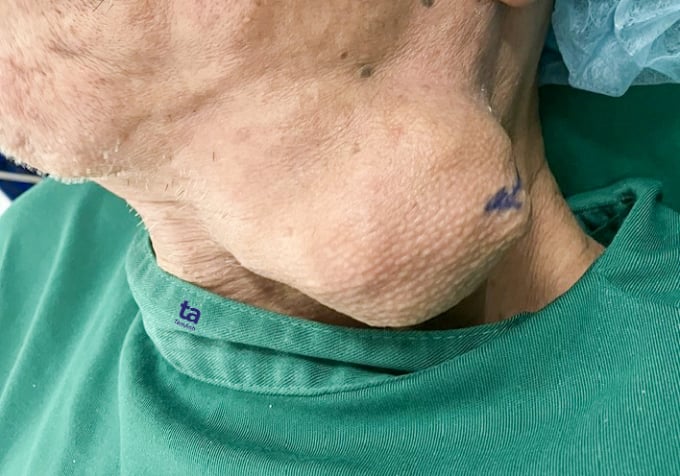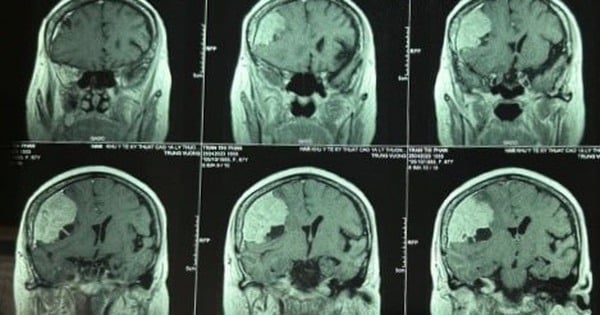Ho Chi Minh City Mr. Giang, 72 years old, 6 years ago had a benign tumor under his left jaw, now the tumor is growing rapidly causing difficulty swallowing, the doctor diagnosed salivary gland cancer.
When first discovered, the tumor was only about the size of a fingertip, did not cause any unusual symptoms and was diagnosed as benign by the doctor, so Mr. Giang did not return for a check-up. For the past two months, he has had a poor appetite and lost 3 kg, so he went to Tam Anh General Hospital in Ho Chi Minh City for a check-up.
Ultrasound results showed that the tumor was 5x7x12 cm in size, clearly defined and had not invaded the left carotid artery. Cytology determined that this was a submandibular salivary gland tumor, a type of pleomorphic adenoma (mixed tumor).
On November 29, Dr. Huynh Ba Tan, Department of Breast - Head and Neck Surgery, said that although the tumor is benign, if it increases in size quickly, it may have turned malignant. The patient was advised to have surgery to remove the submandibular gland containing the tumor as soon as possible.

The patient's submandibular tumor is 12 cm in size. Photo: Nguyen Tram
The surgical team dissected and completely removed the left submandibular gland containing the tumor, preserving the marginal mandibular nerve, lingual nerve, and hypoglossal nerve. Pathology results showed that the tumor was malignant, stage 3, and the patient continued with radiation therapy.

Doctor Ba Tan consults a patient. Photo: Nguyen Tram
Salivary glands include major and minor glands distributed throughout the oral cavity, mainly in the palate and in the upper digestive tract (esophagus, stomach, duodenum).
Dr. Tan said that most salivary gland tumors are benign, only 5% are cancerous. Of these, 60% are malignant parotid tumors, 30% are malignant submandibular tumors, 10% are malignant sublingual and minor salivary gland tumors.
Some benign salivary gland tumors such as pleomorphic adenoma and cylindrical adenoma can also turn malignant. With pleomorphic adenoma, the time to turn into cancer occurs about 15-20 years from the appearance of the benign tumor. Depending on the development of the cells, the tumor can turn malignant earlier.
Benign cylindrical tumors may slowly transform into adenoid cystic carcinoma. This is the second most common type of salivary gland cancer, which grows slowly and spreads along nerves. The prognosis of this type of cancer is less severe than that of adenocarcinoma pleomorphic.
Doctor Tan advises patients who discover an abnormal tumor to see a doctor immediately for timely diagnosis and treatment. In case of benign tumors, patients should have regular follow-up and not be subjective. Tumors that are too large will affect aesthetics, compress the esophagus and larynx, causing difficulty swallowing and breathing, and adhere tightly to surrounding tissues, making surgery difficult.
Nguyen Tram
| Readers ask questions about cancer here for doctors to answer |
Source link


![[Photo] Opening of the 4th Summit of the Partnership for Green Growth and the Global Goals](https://vstatic.vietnam.vn/vietnam/resource/IMAGE/2025/4/16/488550ff07ce4cd9b68a2a9572a6e035)

![[Photo] President Luong Cuong receives Ethiopian Prime Minister Abiy Ahmed Ali](https://vstatic.vietnam.vn/vietnam/resource/IMAGE/2025/4/16/504685cac833417284c88a786739119c)
![[Photo] Many practical activities of the 9th Vietnam-China border defense friendship exchange](https://vstatic.vietnam.vn/vietnam/resource/IMAGE/2025/4/16/3016ed3ef51049219574230056ddb741)

![[Photo] North-South Expressway construction component project, Bung - Van Ninh section before opening day](https://vstatic.vietnam.vn/vietnam/resource/IMAGE/2025/4/17/ad7c27119f3445cd8dce5907647419d1)




















![[Photo] National Assembly Chairman Tran Thanh Man meets with Ethiopian Prime Minister Abiy Ahmed Ali](https://vstatic.vietnam.vn/vietnam/resource/IMAGE/2025/4/16/c196dbc1755d46e4ae7b506c5c15be55)




















![[Video] Viettel officially puts into operation the largest submarine optical cable line in Vietnam](https://vstatic.vietnam.vn/vietnam/resource/IMAGE/2025/4/17/f19008c6010c4a538cc422cb791ca0a1)















































Comment (0)